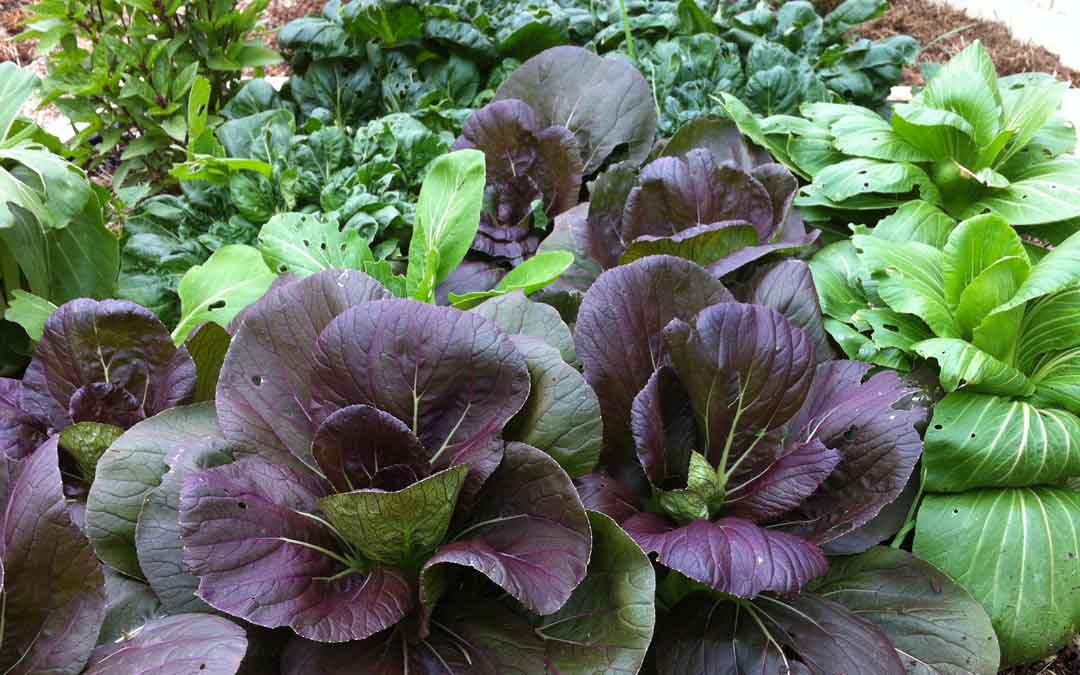While some mustard greens are widely used (especially in Asian cuisine), most are not well known in Australia. This is a pity as they are healthy, tasty, quick growing, and definitely best when harvested fresh from the garden. Just as mustard has quite a bite, so do the leaves of mustard greens. They are great for salads when young, and good in stir fries when a bit older.
Edible mustard greens are members of the genus Brassica, which includes other vegetables such as cauliflower, cabbage and broccoli. Their botanical names include Brassica juncea and Brassica rapa.
Varieties of Brassica juncea include:
Green Wave, Wasabina, Japanese Giant Red Mustard or Mustard ‘Red Giant’, Curled Mustard, Southern Giant, Golden Streaks, Osaka Purple, Mizuna – both green and purple*, Gai Choi, Tender Green, Yukina Savoy, Tatsoi (sometimes classified as Brassica rapa) and Scarlet Frills.
Varieties of Brassica rapa include:
Mustard Spinach Komatsuna, Pak Choi, Bok Choy, Tokyo Bekana and Japanese Mibuna.
These varieties are all available in Australia (see seed stockists further below).
Other mustards
There are 2 other main types of mustard. Black Mustard is grown for seed and then used to make mustard. Mustard Biofumigant is a non-edible type of mustard grown as a soil fumigant. This plant releases compounds that attack soil-borne diseases and disinfect the soil. It is a long-term crop, meaning it needs to grow for 21 weeks and then be dug back into the bed.
Site and soil
Choose a sunny site or area of partial sun depending on the season. Soil should be well drained and contain plenty of organic matter. The soil should not dry out and should be kept weed-free.
Planting
Sow seed directly into soil at a depth of about 5cm. I prefer to broadcast the seed across the soil and then cover, and grow plants tightly together (rather than plant in rows) as this deters pests from eating the leaves. Germination takes 7 -14 days.
Pests
Pests include caterpillars, slugs, snails and earwigs. Use a deterrent for caterpillars, slugs, and snails, and for earwigs put some stakes in the bed and place a down-turned pot stuffed with newspaper on top of the stake. The earwigs will head for the pot of newspaper and you can remove the pot daily or every few days and dispose of the paper and earwigs. Netting them is another option, but secure the hem to the ground to keep crawling pests out. Net does prevent white cabbage butterfly laying eggs on the leaves, preventing the hacthed caterpillars from stripping the juicy leaves, leaving only the ribs and veins.
Harvesting
Snip most leaves for use when they are between 10 -15cm high. They will still be tender at this height. You can also grow them as microgreens, snipping them when they are about 3cm high.
Collect seed
Let some plants go to seed, and collect and store seed for later use.
Where to buy seed
Diggers
The Seed Collection
Happy Valley Seeds
Eden Seeds
Seed Freaks
Bulleen Art and Garden Nursery stock a wide range of mustard greens seed.
Words and Photos by Robin Gale-Baker

